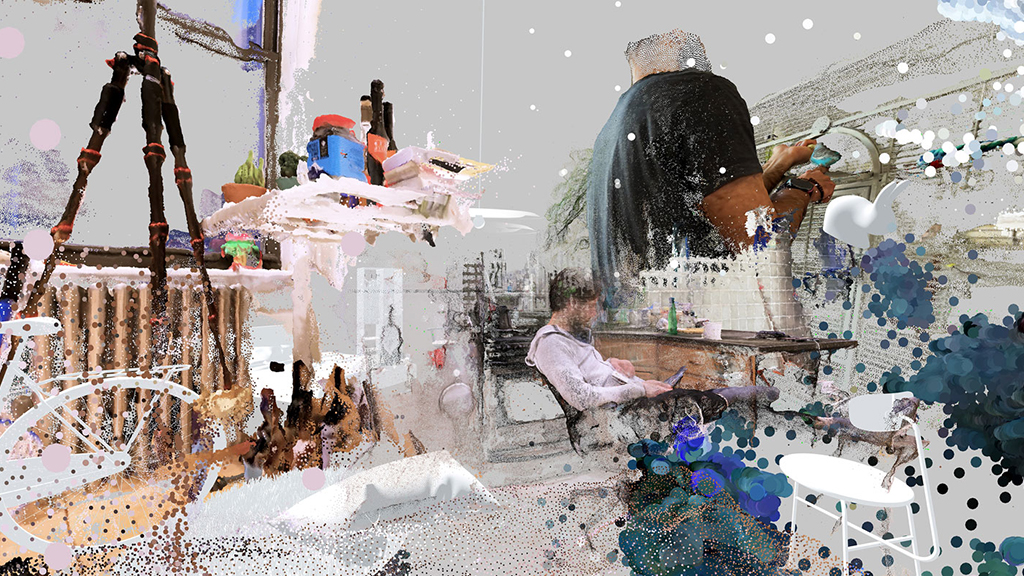UOC professor to show virtual reality experience based on images of homes under lockdown conditions at Paris and Copenhagen festivals
The Smallest of Worlds, which was co-created by Joan Soler-Adillon with Uwe Brunner and Bettina Katja Lange, offers an interactive experience on the value of intimate spaces
Pick up a video game controller. Put on a virtual reality headset. And suddenly you are in a strangely proportioned 3D space made up of fragments of the interiors of homes from all around the world captured during the COVID-19 lockdown. Meanwhile, you hear a voice talking about the quarantine. Use the controller to select one of the objects in this strange environment to access a new space. And continue experiencing these encounters from the inside, as if you were really there.
This is, in broad strokes, what will be offered by the artistic virtual reality and interactivity project co-created by Joan Soler-Adillon, a professor in the UOC's Faculty of Computer Science, Multimedia and Telecommunications, when it is exhibited for the first time at two major festivals in Paris and Copenhagen.
The project, which is called The Smallest of Worlds, is "a reflection on the value of private space, which takes you to strange places, as if you were in a dream or some kind of spatial poem", explains Soler-Adillon. The Catalan artist, who is an expert in interactive communication and digital art, created it with the Austrian architect Uwe Brunner and the German stage designer Bettina Katja Lange.
The title, as Soler-Adillon says, is a play on words: "Everyone's world has become smaller and the world is small because the same thing is happening everywhere". That is, we have been at home more than ever, establishing a new relationship with intimacy within its walls, while also, in many cases, showing our inner sanctums to others more than ever, via social media, video calls and virtual work meetings.
Soler-Adillon adds that The Smallest of Worlds is also an example of practice-based research: "We wanted to experiment with flash fiction; we wanted to see if there were stories that would not work as conventional documentaries that could be told with virtual reality; we asked ourselves how we could create fragmented, unrealistic environments with which people could also make an emotional connection."
The piece has been warmly received, and in April it will receive its premiere at two of Europe's leading festivals, where the state of affairs has forced the artists to present two different versions.
Specifically, on 6 April, it will feature at Les Ailleurs, a new Parisian festival with an impressive mise-en-scène and list of participants, where the work can be visited in person as a physical and virtual reality installation. And, on 21 April, the prestigious documentary festival CPH:DOX (Copenhagen International Documentary Film Festival) will virtually open its doors. There, The Smallest of Worlds can be seen in its online version. The project has also been nominated as a finalist at DOK.fest München.
Contributions from around the world
Where are the environments that appear in The Smallest of Worlds from? They are compositions created from a selection of more than 300 videos sent by people from all around the globe in response to the three artists' call for volunteers to capture their intimate spaces in images. The result is a collaborative piece that is very different to the original videos in terms of colour, texture and the proportions of the objects and people appearing in them.
The artists created the spaces based on the photogrammetry technique, which according to the UOC professor makes it possible to convert video images into 'imperfect' 3D environments.
The exhibition also includes messages spoken by the people who sent the videos, in which they either recount their experience during the first few days of lockdown or take stock of it some months later. English, Catalan, French, Chinese, Hindi and Swiss German are just some of the languages that can be heard.
For example, "in one of the spaces, you can see my daughters playing under the roof of the farmhouse where we live mixed with a chaotic room in Mexico sent by someone we don't know, while a girl explains, in French, how her family spent lockdown at their house in Morocco shortly after having moved to that country", said Soler-Adillon.
The project began a month before lockdown
Soler-Adillon and his two project partners met in February 2020 on an artist-in-residence programme at Barcelona's Espronceda Institute of Art and Culture. They collaborated on a photogrammetry project there and agreed to continue working in the same field over the following months.
And then the pandemic and the state of alarm hit. Even though Soler-Adillon was not able to work in person with Uwe Brunner or Bettina Katja Lange, in June they once again collaborated on an artist-in-residence programme, this time virtually, at a German festival, and in October they presented an initial version of the project at the DOK Leipzig festival.
As for the future, Soler-Adillon does not rule out bringing The Smallest of Worlds to Catalonia, and stresses that it remains to be seen how far the endeavour could be taken. He said, it would be interesting to 'build a community around this project'.
Press contact
-
Editorial department
